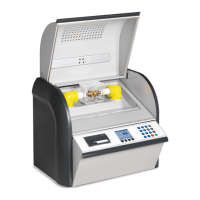
Do you have a question about the Baur DTA 100 C and is the answer not in the manual?
| Brand | Baur |
|---|---|
| Model | DTA 100 C |
| Category | Test Equipment |
| Language | English |
Guidance on how to read and use the manual effectively.
Details on firmware versions and instruction applicability.
Explains the presentation of safety warnings and symbols.
Explanation of symbols used for instructions and information within the manual.
Disclaimer that graphics may differ slightly from the actual device state.
Qualifications and knowledge required for safe operation.
Primary function and limitations of the oil breakdown voltage tester.
General guidelines for safe operation and maintaining product condition.
Highlights risks of high voltage and necessary precautions.
Lists required PPE based on workplace risk assessment.
Visual overview of the device with labeled parts and functions.
Identification and function of buttons, screen, and controls.
Details on USB connection type and voltage/frequency requirements.
Explanation of information provided on the device's rating plate.
How to navigate the device's menu system using controls.
Methods for inputting numerical values via keypad or arrow keys.
Explanation of symbols and abbreviations found in the device interface.
Overview of main menu items and their functions.
Accessing device details like serial number and USB port info.
Crucial checks for mechanical, electrical, and cleanliness before initial use.
Guidance on device placement and proper earthing procedure for safety.
Step-by-step instructions for changing electrode types.
Procedures for cleaning electrodes and setting the correct gap.
Instructions for filling the test vessel, including sampling guidance.
Detailed steps for correctly inserting the test vessel into the tester.
Procedure for powering on the device and its self-test sequence.
Adjusting the screen brightness and auto-dimming timeout.
Options to change device language and printer status.
Configuring log memory behavior and IEC 60156:2018 standards.
Setting hold time and stirrer operation for IEC 60156 tests.
Selecting the correct electrode shape for IEC 60156 measurements.
Configuring ASTM standards and choosing to display individual values.
Setting the hold time before the first measurement for ASTM tests.
Setting electrode shapes and distance for custom tests.
Adjusting device date/time and resetting all settings to defaults.
Table detailing factory settings for various standardized oil testing standards.
Step-by-step guide to performing a measurement according to a selected standard.
Steps for performing a quick evaluation of oil status.
Guide to creating a new custom measurement profile.
Using standard measurements as templates for custom tests.
Loading templates and setting initial hold time for custom tests.
Configuring stirrer operation and voltage slew rate for custom tests.
Setting pause duration and stirrer activity between measurements.
Defining number of tests and maximum output voltage.
Configuring withstand voltage test parameters like steps and duration.
Choosing which measured values to include or exclude from results.
Step-by-step instructions for saving configured custom measurements.
Procedures for executing previously created custom measurement profiles.
How to modify or remove saved custom measurement profiles.
Example of a printed measurement log with all relevant details.
Instructions for viewing measurement logs directly on the device screen.
Explains the purpose and features of the BAUR ITS Lite software.
Step-by-step guide for installing and launching the BAUR ITS Lite software.
Safety warnings and procedures for cleaning the device.
Step-by-step guide for replacing the printer paper roll.
Instructions for replacing the printer ink ribbon.
Procedures for replacing the fuse and information on device calibration.
List of order numbers and descriptions for available accessories and parts.
General steps to follow when a fault occurs and data to provide.
Table of errors, causes, and corrective actions for troubleshooting.
Guidelines for packaging and safely transporting the device.
Instructions for storing the device, including temperature and position.
Instructions for environmentally friendly disposal of the device and insulating oil.